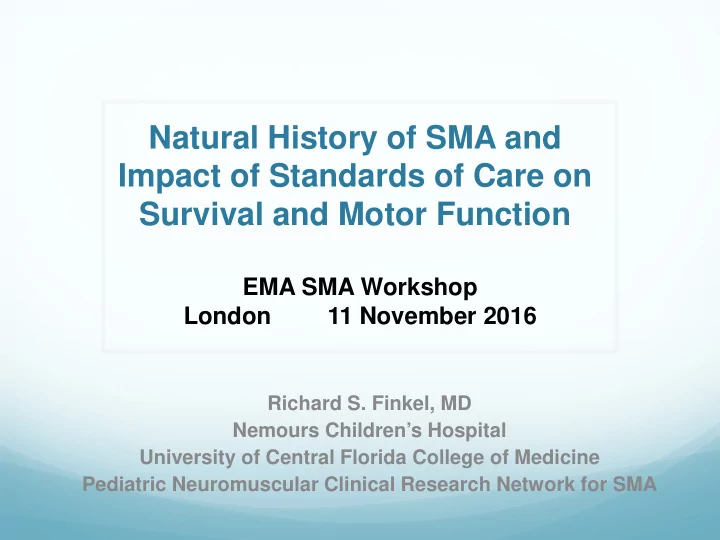

Natural History of SMA and Impact of Standards of Care on Survival and Motor Function EMA SMA Workshop London 11 November 2016 Richard S. Finkel, MD Nemours Children’s Hospital University of Central Florida College of Medicine Pediatric Neuromuscular Clinical Research Network for SMA
Disclosures, SMA-related Grant support: Cure SMA, NIH, SMA Foundation, Ionis, Biogen Advisory: Ionis, Biogen, Roche, Novartis, AveXis, CureSMA, SMA Europe, SMA Reach, MDA DSMB: Roche, AveXis
Spinal Muscular Atrophy 2016 6 drugs in clinical NIH targets SMA development SMN genes SOC Guidelines identified Kolb and Kissel, Arch Neurol 2011
The Clinical Spectrum of SMA Incidence % Prevalence % Maximum SMN2 Age at Symptom Life Type Motor copy Onset expectancy Function number 0 Fetal <1 0 Nil Days -Weeks 1 1 < 6 1A: B-2 Weeks 60 15 Never sits < 2 years Months 1B: <3 Months 1 , 2 , 3 1C: >3 Months 2 6-18 25 70 Never walks 20-40 years 2, 3 ,4 Months 3 1.5-10 3A: <3 Years 15 15 Walks normal 3 , 4 , 5 Years 3B: > 3 Years Rregression 4 >35 <1 1 Slow decline normal 4, 5, 6 Years
SMA, Type 1 Infantile form, “ Werdnig-Hoffmann Disease ” 4 years SMN2CN = 3 3 years SMN2CN = 2 Typical type 1 SMA infant at age 4 months
Early Natural History Studies not genetically confirmed, no supportive care Lead Author, Year Published Survival time Age at death (months): Years when data were collected Months (m) Mean (M) and median (m) (range) Country, number reported (n) Years (y) Brandt, 1950 56% died by 12M of age Denmark, n=76 80% died by 4 years of age Byers, 1961 2 survivors, M=17 m Symptom onset < 2 months (Types IA and IB): 1950-61, USA 23/25 died, 2 sat, M=10 (0.5-52) N=52 Symptom onset 2-12 months (Types IC and II): 5 of 19 died, M=25 (7-73) None live >3 years Pearn, 1973 M=5.9, m= 7 1961-70, England, n=76 95% died by 18 months Thomas, 1994 “few live beyond 2 years” (n=29) M=9.6 , m=7 (1-24) 1982-90 Symptom onset <2 months: m=5.5 England, n=36 Symptom onset > 2 months: m=17 Ignatius, 1994 Uniformly poor if (n=69) M=8.75, m=7. 1960-88 symptoms onset < 2m, Age at symptom onset and median age at death: Finland, n=71 variable if onset 2-6m birth, m=4; 1-2 mos, m=7.5; 4-6 mos, m=17.5 Zerres, 1995 2 years=32% 1985-95 4 years=18% Germany, n=197+90 10 years=8% 20 years =0 (n=18) M=11 (3.4) years (5-24 years) Borkowska, 2002 10% lived >5 years Poland and Germany, n=349
Contemporary Natural History Studies genetically confirmed, some supportive care Lead Author, Year Published Survival time Age at death (months): Years when data were collected Months (m) Mean (M) and median (m) (range) Country, number reported (n) Years (y) Ioos oos, 2004 2004 IB: 18% alive with TV (8-17Y) IB: (n=27 of 33, 82% mortality), M=18 (29) France ce, , n=68 ( 8 (1B=33, 33, 1C=35) 35) IC: 74% alive (? range) IC: (n=9 of 35, 26% mortality), M=4 Years (3.75Y) 82% alive at M=66.1 ± 44.8m Unsupported (n= 18), M=9.6 ± 4.0 Bach, 2007 2007 Supported (n=74), 13 died: M=32.9 ± 50.4, one at 270 1996-2006 1996 2006 ; US USA, n n=74+ 4+18 18 Osko koui 2007, U USA mai mainly ly 1980-1994 ( 1980 1994 (n=65) 65) m=8.5m M=19.1, m=7.3 (1.0-193.5) 1995 1995-2006 ( 2006 (n-78 78) m=indeterminate M=22.1,m=10.0 m (2.5-112.0) Rudnik-Schöneborn, 2 2009 Alive at 2Y: Mortality in 57 (86.3%): 2000-05 d 2000 diagn gnosis Overall: 6% All patients: M=9.0 (few days-55 months), m=6.7 Germ rmany, n , n=66 SMN2CN2: 2% SMN2NC=2 (n=57): M=7.8, m=6. 6.5 ( 5 (0.5-30) 30) SMN2CN3: 67% SMN2CN=3 (n=5): M=28.9, m=19 ( 19 (10. 0.1-55. 55.1) 1) Lemoine, 2012 2012 4 year survival: Proactive c care ( (n=23; 23; 6 6 deaths) s): m m=7. 7.6 ( 6 (IQR 6 6.5,10. 10.5) 5) 2002 2002-09 09 Proactive: 72% Supportive c care ( (n=26; 26; 1 16 deaths) s), m m=8. 8.8 ( 8 (IQR 4 4.7, 7, 2 23.7) 7). USA, SA, n n=49 Supportive: 33% Finke kel. 2014 2014 ( 2005 2005-09 e 09 enrolment) Combined endpoint: Death (n=9): m=9 (2-14) foll ollowed f for or u up to 3 o 3Y Type IB, m=11.9 Death or requiring >16 hours of BiPAP/day: USA, SA, n n=34 Type IC, m=13.6 Overall group: 13.5 m (IQR: 8.1-22) SNM2CN = = 2: 2: 10. 10.5 m m (IQR: 8. 8.1-13. 13.6 m 6 m)
Oskoui et al, 2007 Finkel et al, 2014
4 Clinical Domains of SMA Motor Pulmonary Patient Centered Nutrition Orthopaedics
Management Issues for Type 1 SMA Evolving Topics Active Discussion Diagnosis Maximize motor function Nutritional Enable communication Respiratory Comfort care Orthopaedic Ethics Acute care Quality of Life Physiotherapy/Rehabilitation Access to new treatments Updated Standard-of-Care guidelines are being finalized
Comfort Care Palliative care focus Oral secretions Breathing comfort Nutrition comfort Activity options, e.g. hydrotherapy
Impact of Enhanced SOC Better nutrition and ventilation often leads to improved survival No improvement in motor function, however. Improved quality of life?
Summary Infants with SMA type 1 present with typical pattern of weakness and breathing impairment After an initial precipitous decline there may be a plateau phase with slower decline Survival depends upon age of presentation, SMN2 copy number, avoidance of pulmonary infections and extent of supportive care Motor function does not improve from the time of diagnosis.
Thank you
Recommend
More recommend